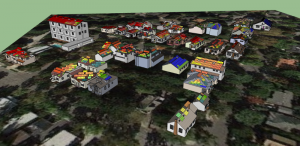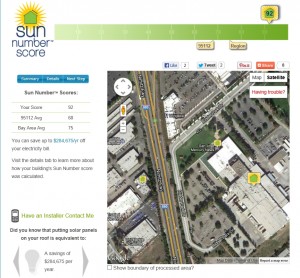A web-based program funded by the U.S. Department of Energy redraws the approach for finding a property’s solar potential.
By David Herrmann
Web-based technologies are having a transformative impact on many industries by enabling companies to conduct key business functions in a way that is faster, less expensive and more responsive to customer needs. Just think about how easy it is today to stream a movie on a rainy day compared to the process of driving to a rental store just a few years ago and hoping there is something good on the shelf. Digital technologies have re-invented processes that were previously slower, more labor-intensive and expensive in the analog era, and that same kind of transformation is poised to happen in the solar industry in a way that benefits both solar installers and customers.
Before we get into that technology, though, we should all admit something about energy and solar technology: It’s confusing to customers. For average homeowners or property owners, their understanding of energy consumption likely doesn’t go much beyond a rough estimate of what their last utility bill cost. Many have no idea how much they consume in terms of kilowatt hours, let alone understanding whether their property is a good candidate for rooftop solar panels. The U.S. Department of Energy (DOE) recognizes that need for public education, and it sees digital technology as a key to make it simpler for property owners to understand how they can benefit from solar installations. The DOE strongly believes that a better-educated, energy-savvy public will grow the solar market in a way that drives revenue for installers.

IMMEDIATE ANALYSIS
The Sun Number web-based computer program can instantly determine if a rooftop is ideal for solar. This saves the installer and customer time, paperwork and headaches.
In addition to growing the market and driving revenue for solar companies, the DOE also sees digital technology as critical for helping solar companies respond faster to sales opportunities while also lowering the cost of pursuing each potential customer. “Hard costs” — the cost of PV panels and related hardware — have decreased over the past several years thanks to lower cost of manufacturing. However, while the costs of the panels have fallen drastically over the past several years, the National Renewable Energy Laboratory (NREL) recently reported that soft costs made up almost 40 percent of the cost structure for solar providers in 2012, including the cost of customer acquisition, the cost of permitting, overhead, taxes, etc.
One of the largest components that make up the soft costs is the cost of customer acquisition. Estimates of the cost of customer acquisition today range from $2,000 to $3,000 per customer, which can equate to more than $0.50 per watt for small installers and $0.20 to $0.30 per watt on average. Much of the cost of customer acquisition is in two areas: 1) money spent to engage consumers and get them to take action, and 2) money spent on evaluating and providing quotes on properties that have not been properly vetted for solar potential. The DOE’s most recent round of SunShot grants has placed a special focus on reducing these soft costs, and that is where web-based technologies come into the story.
In 2012, Sun Number received a grant to complete development of a web-based solution that would address both of those aspects of customer acquisition. In addition, the SunShot grant asked Sun Number to develop its solution in a way that would also educate the public about the benefits of energy that would drive sales leads to solar installers.

EASY INPUT
Using high-resolution data and GIS software, the Sun Number program evaluates rooftop details and scores each building. In this example, the building receives a 92, meaning it is pretty close to perfect for solar generation.
Sun Number’s solution is a web-based application that enables solar companies to get instant analyses of the rooftop solar potential of a property while the company is on the phone with the potential customer. This is a dramatic change from the traditional method of doing rooftop analyses, which requires an employee to wait for good weather, roll a truck to the property, climb up on the roof and conduct a physical examination that typically requires half a day. Then when the employee returns to the office, there is still quite a bit of work to be done in preparing a report that the sales team can use for a followup conversation with that customer.
That “pre-digital” process often takes seven to 10 days in total, which brings the sales process to a halt. It also adds a significant amount of soft costs to the process, totaling hundreds or even thousands of dollars. The DOE was excited about Sun Number’s web-based approach because it eliminates those 10 days by providing instant analyses, and a web-based solution also reduces the cost of solar assessments by up to 90 percent through a low-cost web service that is much less expensive than the labor-intensive traditional method.
Sun Number uses high-resolution aerial data and GIS software that evaluates the rooftop details of every building in a city. The rooftop pitch and orientation is computed allowing Sun Number calculations to only include roof planes that are ideally suitable for solar PV. It also de-rates the solar production of portions of the roof that are oriented west and east compared to portions that are oriented south. Sun Number uses LiDAR as the aerial data and has algorithms that factor in local weather conditions, the impact of shade from surrounding vegetation and buildings and other factors that would impact solar suitability. An analysis is provided on-demand to solar installers by simply typing in the building address into the website.
The report provides all of the information that an on-site visit would produce, plus additional information that is only possible through a Sun Number analysis. For example, a score for each building is created ranging from 1 to 100 as a measure of the rooftop’s solar suitability. A score of 100 is a perfect roof for solar, a score below 50 is an indication that the rooftop is not suitable. Along with the overall score, the tool gives solar providers an estimate of the dollar figure for electricity that rooftop solar on the building would generate, which is a key factoid that customers are interested in hearing. Sun Number also provides information about the likelihood that the owner of the building will qualify for a solar lease or a loan for a solar purchase.
This web-based solution allows solar installers to shorten the sales cycle with customers by instantly providing them with an analysis of how suitable their rooftop is, which enables the dialogue to move on to the price quote phase. This web-based approach also saves hundreds or thousands of dollars in soft-costs for each sales process, enabling solar installers to dramatically reduce their cost structure and increase their margins on each successful sale.
Sun Number has made a version of the tool available free to the public in order to support the DOE’s goal of increasing public education about solar energy. Homeowners and other property owners can look up their own address, get a Sun Number Score for their home, compare their score against the local average, get an estimate of how much they could save off their utility bill and then click to connect with a local solar installer to start a dialogue. To see a demo of the tool, visit sunnumber.com.
Dave Herrmann has extensive experience in the solar industry and is a co-founder of Sun Number. He is now leading the company’s business development efforts. Visit sunnumber.com for more info.
— Solar Builder magazine
[source: http://www.solarbuildermag.com/featured/sun-number-sunshot-doe/]

Leave a Reply
You must be logged in to post a comment.